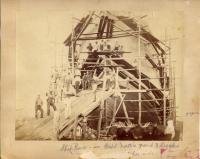
Baring Brothers Launch, Thomaston 1877
Thomaston Historical Society
Text by Richard Judd
Images from Thomaston Historical Society,
Native peoples of Maine built dugout canoes, utilizing the rich forest resources of the area to access its equally rich river resources. Later, they shifted their boat-building skills to make birch bark canoes, lighter weight and more maneuverable.
When the English arrived in Maine, the straight white pines drew their attention for the competition among nations for economic and political dominance demanded powerful navies and had long since depleted their own stocks of wood suitable for masts and shipbuilding.
The northeast coast, with its accessibility to England and its sheltered ocean ports, became a center of shipbuilding.
After the American Revolution and continuing through contemporary times, Maine's seaport towns and cities have built ships, some exclusive to the fishing and shipping needs of Maine.
Even as the wooden sailing ship era was coming to an end, Maine shipyards built ships that could do things others could not, capturing the remaining elements of the market. For instance, the Down-Easter, designed and built exclusively in Maine, combined speed, cargo capacity, and strength – a combination necessary to match the brutal weather off Cape Horn with a shifting cargo of wheat.

Four-mast bark 'Roanoke' under sail, 1892
Maine Maritime Museum
The Sewall yards in Bath built the Rappahannock, the Shenandoah, the Susquehannah, and the Roanoke in the early 1890s as Bath’s last contribution to the square-rigged tradition, and the last wooden square-rigger in the United States, the Aryan, was built on the Kennebec in Phippsburg in 1893.
While most clippers were built in New York and Massachusetts, Bath and Waldoboro contributed their share, including the much-acclaimed Red Jacket, launched in 1853 from the George Thomas shipyard in Rockland. On its maiden voyage, Red Jacket sailed from New York to Liverpool in 13 days, a record for sailing ships unbroken to this day.
Early fishing vessels, called Chebacco boats, were designed primarily for near-shore fishing, but larger versions of these sturdy, high-stemmed and sharp-sterned craft, called pinkies, could voyage as far as Labrador. Pinkies were followed by larger schooners designed for fishing the offshore banks and carrying the catch to the West Indies.

Ship Reuce, Kennebunk, 1881
Brick Store Museum
Huge five- and six-masted schooners were built in Bath, Waldoboro, Rockland, and Camden. During the Civil War northern shippers abandoned transatlantic voyages to carry goods along the coast and into Canada, and because these voyages required a great deal of maneuverability, Maine produced gigantic schooners – vessels rigged fore-and-aft for steering into the wind.
Since federal law prohibited foreign vessels from carrying goods from one American port to the next, and because wooden ships were still competitive in carrying bulky cargoes, these vessels dominated the coasting trade, particularly in coal. Along with cargo capacity and maneuverability, they were simple to operate, requiring about one-third the crew of a square-rigged vessel.

Thomas W. Hyde, Bath, ca. 1876
Maine State Archives
Of the eleven six-masted schooners built in the United States, nine came from Maine, and seven from the Percy & Small yard in Bath. The 3,730-ton Wyoming, built by Percy and Small in 1909, was the largest wooden sailing craft to operate in commercial service. At a time when British steel ships were out-competing the rest of the world, Maine's shipbuilding families carried the craft of wooden shipbuilding to its apogee.
Bath's Arthur Sewall experimented with steel sailing vessels at the turn of the century, completing nine square-riggers, two steel five-masted schooners, and a steel tank barge. When this proved unprofitable, Thomas W. Hyde began constructing steel steamships at the nearby Bath Iron Works, an iron foundry specializing in marine equipment.
In 1890 the company won a contract to build two gunboats for the U.S. Navy, and in later years it built passenger steamships, naval destroyers, yachts, and commercial vessels. Elsewhere, smaller ports turned to producing fishing vessels and recreational sailing craft, a tradition that continues to the present.










